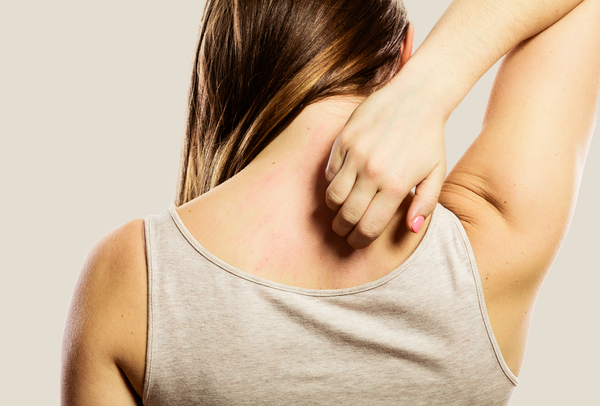If you’re here, you probably know that SEEN is non-comedogenic (won’t clog pores) and safe for sensitive skin. But you may not know that our “safe for sensitive skin” status is due to the results of repeat insult patch testing (RIPT) in subjects with sensitive skin. SEEN avoids many common irritants and allergens to make our products safe for sensitive skin. (For some, fragrance can be an irritant or allergen, which is why all of SEEN’s products are available fragrance-free as well.)
Allergens in haircare (as well as skincare and makeup) can trigger the immune system and activate a true allergic reaction. This is technically called allergic contact dermatitis (ACD), and it generally occurs 48 to 72 hours after exposure to the allergen. This allergic reaction can cause a red, flaky, itchy rash that is not contagious.
Some of the most common allergens in haircare include p-phenylenediamine (PPD), nickel, fragrance (hence our commitment to offering fragrance-free versions of all SEEN products), balsam of Peru, and cocamidopropyl betaine/3- dimethylaminopropylamine, and the preservatives methylisothiazolinone/methylchloroisothiazolinone.[1]
For the record, the hair products most commonly associated with allergic contact dermatitis (ACD) of the scalp are hair dyes (41%), shampoo (28%), and conditioner (22%). According to data from the North American Contact Dermatitis Group, 9% had positive patch test results associated with haircare products from 2001 to 2016.[2] Positive patch tests more than doubled between 1996 and 2016, which shows contact dermatitis caused by personal-care products is clearly on the rise.[3] Even some dandruff shampoos that are recommended by dermatologists contain common allergens such as formaldehyde-releasing preservatives.[4]
The skin on the scalp is thicker than skin on other parts of the body and generally produces more sebum. This seems to protect the scalp from allergic contact dermatitis, so ACD on the scalp is less common. ACD may also develop on areas that come in contact with haircare products while rinsing, such as the face, neck, and ears.[5]
In addition to established allergens that dermatologists generally agree upon, there are also “emerging” allergens. These are ingredients that are closely followed by dermatologists who specialize in contact dermatitis and monitor trending allergic reactions associated with personal-care products.
Dermatologists who are contact dermatitis specialists track emerging allergens through clinical observation, reviewing case reports, and staying current with the latest scientific literature. Presentations at professional meetings often call attention to emerging allergens as well.
Glucosides, for example, were once an emerging allergen but are now considered an established allergen. Glucosides are gentler surfactants that have become increasingly popular ingredients in cleansing products, including shampoos. (A few names you may see on ingredient labels include decyl glucoside, caprylyl/capryl glucoside, coco-glucoside, heptyl glucoside, and lauryl glucoside.)
In 2017, glucosides were named “Allergen of the Year” by the American Contact Dermatitis Society (ACDS). Dr. Peter Schalock, a contact dermatitis expert previously at Massachusetts General Hospital (MGH) who now practices in Sweden, attributes the rise in reports of allergic contact dermatitis caused by glucosides to companies’ movement away from cocamidopropyl betaine-type surfactants (which were “Allergen of the Year” in 2004).
When working on new SEEN product formulations, Dr. Rubin does her homework. She reviews ingredients closely, looks at published research and reports on contact dermatitis, and consults with contact dermatitis specialists about emerging allergens as well.
As a result, all SEEN products are safe for sensitive skin, and all fragrance-free SEEN products have the National Eczema Association’s Seals of Acceptance™. Fragrance-Free Shampoo, Fragrance-Free Conditioner, and Magic Serum have also received SkinSAFE’s coveted “Trusted Choice” seals.
SEEN avoids many irritants, as well as common and emerging allergens, which shows we’re as serious about skin health and being safe for sensitive skin as we are about gorgeous hair.
[1] Pham CT, Juhasz M, Lin J et al. Allergic Contact Dermatitis of the Scalp Associated With Scalp Applied Products: A Systematic Review of Topical Allergens. Dermatitis 2022; 33:235.248.
[2] Warshaw EM, Ruggiero, JL, DeKoven JG et al. Contact dermatitis associated with hair care products: A retrospective analysis of the North American Contact Dermatitis Group, 2001-2016. Dermatitis 2022;33:91-102.
[3] Warshaw EM, Schlarbaum JP, Silverberg JI, et al. Contact dermatitis to personal care products is increasing (but different!) in males and females: North American Contact Dermatitis Group data, 1996-2016. J Am Acad Dermatol. 2021;85(6):1446-1455. doi:10.1016/j.jaad.2020.10.003
[4] Flanagan KE, Pathoulas JT, Walker CJ et al. Legislative update: Regulating ingredients in personal care products. J Am Acad Dermatol 2021;84:1780-1.
[5] Pham CT, Juhasz M, Lin J et al. Allergic Contact Dermatitis of the Scalp Associated With Scalp Applied Products: A Systematic Review of Topical Allergens. Dermatitis 2022; 33:235.248.




